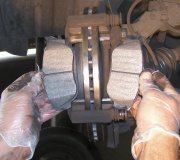First of all, no air got into the system from replacing pads and rotors, so bleeding is not necessary. The most likely suspect is the master cylinder has been damaged. To fit the new, thicker pads over the rotors, the pistons have to be pressed back into the caliper housings. Once everything has been assembled, you need to press the brake pedal a few times to run the pistons back out until the pads contact the rotors. Do-it-yourselfers typically push the brake pedal all the way to the floor.
Crud and corrosion build up in the lower halves of the two bores in the master cylinder where the pistons do not normally travel. During pedal-bleeding, inexperienced people ram the brake pedal all the way to the floor. Doing that runs the rubber lip seals over that crud and rips them. That causes internal leakage, and that may not show up for two or three days. Internal leakage causes the brake pedal to sink slowly to the floor at first, when steady pressure is held on the pedal, but eventually it causes a failure to build any pressure when the pedal is pushed. The same thing is caused when people pedal-bleed the system with a helper. Experienced mechanics avoid this by gravity-bleeding with no helper. If you do resort to using a helper, it is important to never push the pedal over half way to the floor. This is even more important on GM front-wheel-drive cars. Pushing the pedal over half way will trip a valve in the master cylinder, then you will not get any fluid flow to one front wheel and the opposite rear wheel.
To reset that valve, loosen the cap on the reservoir, open one bleeder screw to one of the wheels that is not flowing any fluid, then give that bleeder screw a very short, quick burst of compressed air. The goal is to avoid sending air all the way up to the master cylinder. You just need to move the brake fluid a few inches in the line to reset the valve, then let the system gravity-bleed.
Once fluid is flowing from a wheel, close that bleeder screw, and wait for the next one to start flowing. When all the bleeders are closed, "irritate" the brake pedal a little by hand. That will wash any remaining air bubbles into the calipers or wheel cylinders. Open each bleeder screw, one at a time, to expel those last few bubbles, then you are done.
On some car models with anti-lock brakes, it is necessary to use a scanner to command the computer to open the valves in the hydraulic controller. That allows the air to be expelled from some of the chambers.
Tuesday, January 3rd, 2017 AT 2:31 PM




